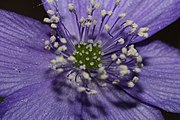
Trillium chloropetalum, also known as giant trillium, giant wakerobin, or common trillium, is a species of flowering plant in the family Melanthiaceae. It is endemic to the western U.S. state of California, being especially frequent in and around the San Francisco Bay Area.

Anemonoides nemorosa, the wood anemone, is an early-spring flowering plant in the buttercup family Ranunculaceae, native to Europe. Other common names include windflower, European thimbleweed, and smell fox, an allusion to the musky smell of the leaves. It is a perennial herbaceous plant growing 5–15 cm (2–6 in) tall.

Commelina is a genus of approximately 170 species commonly called dayflowers due to the short lives of their flowers. They are less often known as widow's tears. It is by far the largest genus of its family, Commelinaceae. The Swedish taxonomist Carl Linnaeus of the 18th century named the genus after the two Dutch botanists Jan Commelijn and his nephew Caspar, each representing one of the showy petals of Commelina communis.
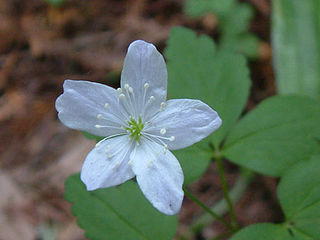
Anemonoides quinquefolia, a flowering plant in the buttercup family Ranunculaceae, is native to North America. It is commonly called wood anemone or windflower, not to be confused with Anemonoides nemorosa, a closely related European species also known by these common names. The specific epithet quinquefolia means "five-leaved", which is a misnomer since each leaf has just three leaflets. A plant typically has a single, small white flower with 5 sepals.

Thalictrum thalictroides, synonym Anemonella thalictroides, the rue-anemone, is a herbaceous perennial plant native to woodland in eastern North America. It has white or pink flowers surrounded by a whorl of leaflets, and it blooms in spring.
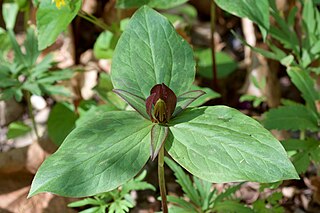
Trillium sessile is a species of flowering plant in the bunchflower family Melanthiaceae. The specific epithet sessile means "attached without a distinct stalk", an apparent reference to its stalkless flower. It is commonly known as toadshade or toad trillium. It is also called sessile trillium or sessile-flowered wake-robin,, however it is not the only member of the genus with a sessile flower.

Primula pauciflora, the pretty shooting star, few-flowered shooting star, dark throat shooting star or prairie shooting star, is a species of flowering plant in the primula family Primulaceae. It is a widespread and very variable species, native to western North America, from Subarctic America to Mexico, often in xeric and desert habitats. It is found in the Great Basin Deserts and Mojave Desert. Its synonyms include Dodecatheon pauciflorum and Dodecatheon pulchellum.
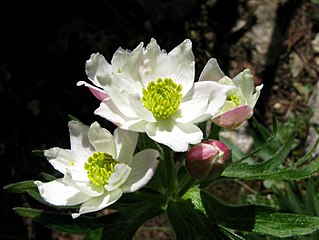
Anemonastrum narcissiflorum, the narcissus anemone or narcissus-flowered anemone, is a herbaceous perennial in the genus Anemonastrum and the buttercup family. Basionym: Anemone narcissiflora Hook. & Arn.
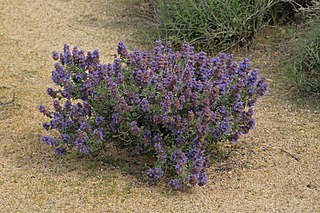
Salvia dorrii, the purple sage, Dorr's sage, fleshy sage, mint sage, or tobacco sage, is a perennial spreading shrub in the family Lamiaceae. It is native to mountain areas in the western United States and northwestern Arizona, found mainly in the Great Basin and southward to the Mojave Desert, growing in dry, well draining soils.

Anemone multifida is a species of flowering plant in the buttercup family known by the common names cutleaf anemone, Pacific anemone and globe anemone. It is a perennial herb native to northern North America from Alaska to New York and as far south as Arizona and New Mexico. It is also known from parts of South America.
This glossary of botanical terms is a list of definitions of terms and concepts relevant to botany and plants in general. Terms of plant morphology are included here as well as at the more specific Glossary of plant morphology and Glossary of leaf morphology. For other related terms, see Glossary of phytopathology and List of Latin and Greek words commonly used in systematic names.
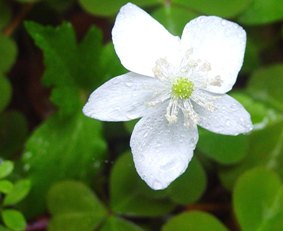
Anemonastrum deltoideum, also known by the common names Columbian windflower and western white anemone, is a species of flowering plant in the buttercup family Ranunculaceae. It is native to the forests of the west coast of the United States. This is a rhizomatous perennial herb growing between 10 and 30 centimeters tall. There is usually a single basal leaf which is divided into three large toothed leaflets, each up to 6 centimeters long. There may be more leaves along the mostly naked stem which are similar in appearance to the leaflets on the basal leaf. The inflorescence has three leaflike bracts and a single flower. The flower has no petals but five petal-like white sepals each one to two centimeters long. There are up to 120 whiskery stamens and many pistils. The fruit is a cluster of spherical achenes.

Parnassia californica is a species of flowering plant in the family Celastraceae known by the common name California grass of Parnassus. It is native to the mountains of Oregon, California, and Nevada, where it grows in moist areas such as meadows and streambanks.

Eriocapitella hupehensis, a species of flowering plant in the buttercup family Ranunculaceae, is native to Asia. The specific epithet hupehensis, which means "from Hupeh province, China", refers to a region where the species is known to occur. In Chinese, it is called dǎ pò wǎn huā huā (打破碗花花), which means "broken bowl flower".

Enemion biternatum, commonly known as the false rue-anemone, is a spring ephemeral native to moist deciduous woodland in the eastern United States and extreme southern Ontario.

Sidalcea oregana is a species of flowering plant in the mallow family known by the common name Oregon checkerbloom.

Trillium kurabayashii is a species of flowering plant in the bunchflower family Melanthiaceae. The species is endemic to the western United States, occurring in extreme southwestern Oregon, northwestern California, and the Sierra Nevada of northern California. It was first described by John Daniel Freeman in 1975. The specific epithet kurabayashii honors Masataka Kurabayashi, a Japanese cytologist and population geneticist who first postulated the taxon’s existence. It is commonly known as the giant purple wakerobin, a reference to its conspicuously large, dark purple-red flower, one of the largest of any sessile-flowered trillium.

Saribus brevifolius is a species of palm tree in the genus Saribus, which has only been found in the Kawe and Gag Islands in the archipelago of the Raja Ampat Islands, which lie off the north-west tip of the Bird's Head Peninsula in Indonesia's West Papua province. It was only discovered in 2002 during an expedition funded by The Nature Conservancy. The palm grows along the coasts of these two tropical islands on small ridges composed of ultrabasic rock. It is a moderately-sized fan palm with smallish and regularly segmented leaves and a smallish inflorescence in the crown. The inflorescence is not longer than the leaves, and split at its base into three main branches with one or more sub-inflorescences, these containing red flowers with pink anthers. The ends of S. brevifolius leaf segments are rigid and have a bifurcate cleft 1-4% of the segment length.
Zanthoxylum dissitum is a woody plant native to China. It grows in upland thickets and open forests, forests, at 300-2600 m altitude.
Zanthoxylum echinocarpum is a woody plant in the family Rutaceae and is native to South-Central and Southeast China.


